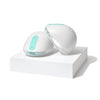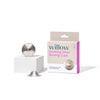It's completely natural and nothing to be alarmed about

Did you know that breast milk comes in a variety of colors? We know, crazy!
One of the most surprising things about breast milk is that it can change colors. But don't worry, this is completely natural and nothing to be alarmed about. In fact, if you are exclusively breastfeeding, you might not even notice the changes.
Breast milk is an amazing thing - filled with nutrition, antibodies, and love. While every journey will be different, it is important to know what makes up your milk and what you can expect to see along the way.
The Three Evolutionary Stages of Breast Milk

Breast milk changes as baby grows and as their nutritional needs change.
Your breast milk will go through three different stages: colostrum is first, then it becomes transitional milk, and finally, mature milk.
Colostrum
Colostrum is the first milk that your breasts produce. It is thick and yellow in color, and is often referred to as "liquid gold."
Colostrum is rich in antibodies and other immune system components that help protect your baby from infections and illnesses. So much so that many moms harvest and freeze their colostrum to give to their children when they get sick!
It also contains high levels of protein, which helps your baby's developing digestive system learn how to process food.
Transitional Milk
Transitional milk is the next stage of breast milk. It starts to appear about two to five days after birth and continues for a few weeks. Transitional milk is thinner than colostrum and has a creamier color. It still contains immune system components and protein but in lower concentrations.
Mature Milk
The third stage of breast milk is mature milk, which typically appears around two weeks postpartum.
This milk is white or creamy and contains the perfect balance of fats, carbohydrates, and proteins to meet the nutritional needs of your baby. Mature milk is also high in antibodies and immune-boosting cells to help protect baby from infection and illness.
Mature milk is broken down into two types: foremilk and hindmilk.
At the beginning of any feeding, the foremilk is the first type of milk that comes out and that your baby receives. This milk tends to be a bit thinner and bluer in color.
As your baby gets deeper into a feeding, the foremilk will transition into hindmilk. Hindmilk is thicker, creamier, and has a more yellow color due to the higher fat content. The fat in hindmilk helps your baby feel full and satisfied until the next feeding.
The Colors of Breast Milk - and What They Mean
While breast milk typically appears white or creamy, it can change colors for different reasons. Here are some of the most common breast milk colors and what they mean:
Blue Breast Milk
If your breast milk appears blue, it's likely due to a buildup of milk in the ducts. This is most common in the early weeks of breastfeeding when the milk supply is still stabilizing. It's generally not a cause for concern and will usually resolve on its own.
Green Breast Milk
Green breast milk can be caused by your diet. If you eat a lot of green vegetables, such as kale or spinach, the chlorophyll in those foods can sometimes cause your breast milk to take on a green tint.
Orange Breast Milk
Orange breast milk can be caused by foods that are high in beta-carotene, such as carrots or sweet potatoes. While seeing orange in your baby’s poop can be alarming, this is completely normal and nothing to worry about.
Pink/Red Breast Milk
If your breast milk appears pink or red, it's often due to a small amount of blood in the milk. This is commonly referred to as "strawberry milk" and can be caused by a cracked nipple, a clogged milk duct, or an infection in the breast. This sounds scary, but it's generally safe for the baby to drink.
Decoding the Rainbow: Common Breast Milk Colors
|
Color |
Common Cause |
Is It Safe? |
|
Blueish/Clear |
Normal Foremilk: A large volume of foremilk at the start of a feeding. |
Yes. This is a normal part of milk composition. |
|
Green |
Diet: Consuming green vegetables (spinach, kale), green drinks, or foods with green dye. |
Yes. The chlorophyll from greens can tint your milk. It's harmless. |
|
Orange |
Diet: Eating orange foods like carrots, sweet potatoes, or squash (high in beta-carotene). |
Yes. This is a common and completely safe color change. |
|
Pink/Red |
Blood: Often from a cracked nipple, rusty pipe syndrome, or a burst capillary. |
Usually. It's typically safe for baby to drink, but the underlying cause (like pain) should be addressed. |
|
Brown/Rusty |
Old Blood: "Rusty Pipe Syndrome," where old blood from increased vascularity in the breasts leaks into milk ducts. |
Usually. This often resolves on its own within a few days. |
Oat Mama Lactation Supplement

Oat Mama's proprietary blend of galactagogues (milk-boosting herbs) includes alfalfa, goat's rue, milk thistle, moringa, shatavari, and spirulina. Plus it's gentle on the tummy.
When to Worry About Breast Milk Color Changes
While most color changes are benign, contact your doctor or a lactation consultant if you experience:
-
Persistent red or pink milk beyond a few feedings, especially if accompanied by breast pain, fever, or redness, which could indicate an infection like mastitis.
-
Black or dark brown milk, which is very rare and should be evaluated.
Any color change that coincides with your baby showing signs of illness or refusing to feed.
FAQs
-
Can my diet really change the color of my breast milk?
Absolutely. Pigments from strongly colored foods (greens, oranges) and even some supplements or food dyes can pass into your milk, causing temporary color changes. This is normal and not a cause for concern. -
Is pink "strawberry milk" safe for my baby to drink?
In most cases, yes. Small amounts of blood from a cracked nipple are not harmful to your baby. However, if the bleeding is persistent, you are in significant pain, or your baby is spitting up blood-tinged milk, you should consult a healthcare provider to address the cause. -
Why does my frozen breast milk sometimes look yellow?
This is completely normal! The high fat content in hindmilk can become more pronounced when frozen, giving it a yellow, buttery appearance. It can also separate, which is also normal—just swirl it gently to re-mix after thawing. -
I'm pumping and my milk looks watery and blue. Am I producing enough fat?
Likely, yes. The first milk you see in a pumping session is foremilk, which is naturally lower in fat and can appear bluish. As you continue to pump, the fattier hindmilk will let down. Ensure you are draining the breast adequately to allow your baby to get the calorie-rich hindmilk.
Pump with Confidence and Clarity
Understanding your milk is one thing; managing the pumping journey is another. The Willow Wearable Breast Pump is designed to give you freedom and insight into your feeding routine.
Pump discreetly, track your sessions, and store milk effortlessly—all while going about your day. Focus on the bonding, and let Willow handle the rest.
Ready to simplify your breastfeeding journey?
Tags Used
















